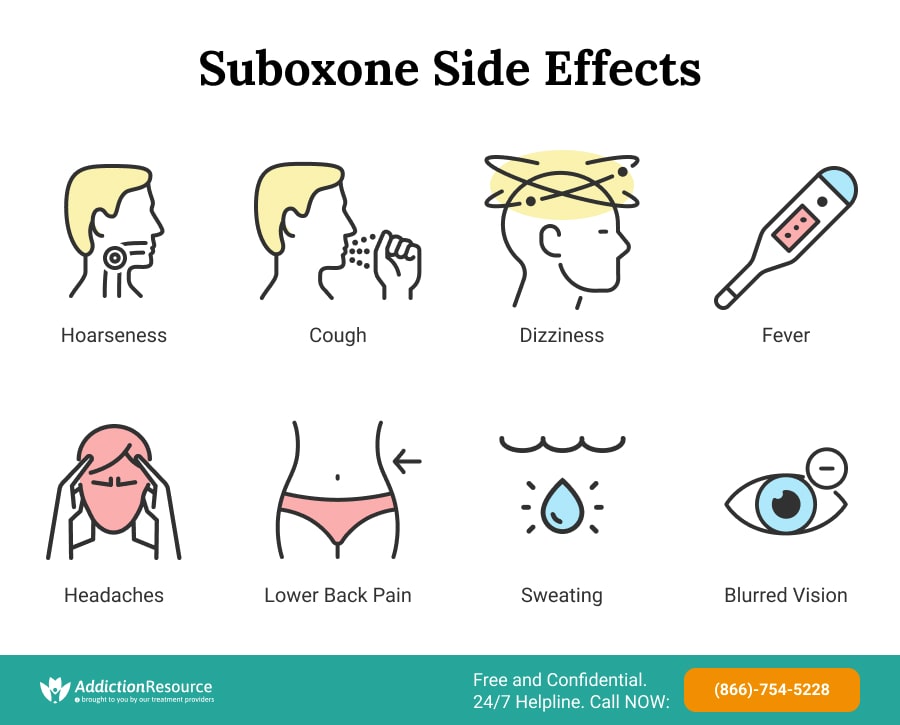Suboxone is a drug for patients who have become addicts of narcotic (opioid) pain medications. They include heroin, morphine, and codeine. It contains two drug components: Buprenorphine and Naloxone.
Using this drug, it’s possible to prevent or even eliminate withdrawal symptoms that occur when people become addicts to narcotics. Of course, like any other medication, Suboxone has its own share of undesirable effects. Above all, one should learn about the side effects of Suboxone. As a result, it may help to minimize the risk or avoid complications that may occur during the therapy.
Table Of Contents:
- What Are the Major Suboxone Side Effects?
- What Are the Minor Suboxone Side Effects?
- Are There Any Long-Term Side Effects of Suboxone?
- What After-Effects Require Urgent Medical Attention?
- What Are Suboxone and Pregnancy Warnings?
- Can a Patient Experience an Overdose?
- How to Minimize the After Effects?

Side effects of a medication are undesirable effects that occur while the user is taking it. In some cases, the side effects may linger even after the patient has discontinued the therapy. One can categorize the side effects of Suboxone into major, minor, and long-term. This is for the ease of recognition and helps one gauge the severity.
Major Side Effects of Suboxone
These unintended signs and symptoms associated with the use of Suboxone warrant immediate medical attention. Unfortunately, failure to do so may result in serious complications.
The Major Side Effects of Suboxone Are:
- A cough or changes in the voice such as hoarseness
- Dizziness or lightheadedness due to low blood pressure
- Feeling of warmth or cold
- Fever or chills
- Flushing on the face and neck
- Headache
- Pain in the lower back or side
- Pain while urinating
- Sweating
- Irregular menstruation
- Slurred speech
- Blurred vision
- Decreased libido
- Fatigue
- Dark-colored urine
- Yellowish skin, eyes, and dark urine indicating jaundice
These complications can cause serious damage to the health requiring further treatment. If any is noticed, contact a doctor or a pharmacist at once.

Minor Side Effects of Suboxone
These adverse effects of buprenorphine treatments for addiction are milder than the major after-effects. They can disappear with or without medical treatment.
Nevertheless, if any of the following complications from the medication persist or cause trouble, a patient should consult the doctor:
- Constipation or diarrhea
- Disturbances in bowel evacuation
- Increased nasal discharge
- Nasal congestion
- Nausea and vomiting
- Pain in the stomach
- Headache
- Opioid withdrawal symptoms
- Increased nasal discharge
- Redness of the mouth
- Depression
- Anxiety
- Sweating
- Back pain
- Diarrhea
- Sleep problems
- Sneezing
- Weakness
Some of these will go away in a matter of days or weeks without treatment. But if they persist and don’t go away or become severe. Then something should be done about it. There are few medications used for the treatments of Suboxone nausea and Suboxone headache. Contact the relevant authorities if need be or for more information.
What Are the Long-Term Suboxone Side Effects?
The two active ingredients in the drug, Buprenorphine, and Naloxone are opioid modulators and opioid agonists respectively. They can also lead to addiction after long-term use for the treatment of alcohol and opioid addiction. In fact, one may also experience some of the withdrawal after-effects after discontinuing the therapy.
The Long-Term Suboxone Adverse Effects Include:
- Abdominal problems like constipation, nausea, and vomiting
- Depression and anxiety
- Feeling drowsy
- Hormonal problems
- Liver damage
- Increased pain sensitivity
- Mental confusion and disorientation
- Unable to socialize
This does not cover all the possible Suboxone side effects. So it’s best to always be on the lookout for any change in health.

Adverse Effects Requiring Urgent Medical Attention
These complications are serious, but they are not always common. Contact a doctor right away if any of this is noticed, and if the symptoms feel life-threatening, do not hesitate to call 911 and report them for emergency treatment.
Allergic Reactions
Allergic reactions can occur with any drug. The symptoms of allergy develop when immune cells launch an abnormal response to the drugs or its constituents. Also, allergic reactions are called hypersensitivity. If a person has known hypersensitivity to Suboxone, or any of the ingredients, like buprenorphine, the information should be given to a doctor in advance.
While on Therapy, One Should Watch for the Following Signs and Symptoms of Allergy. They Include:
- Abnormal heartbeats, too fast or too slow
- Breathing difficulties such as shortness of breath, rapid breathing, tightness in the chest
- Hives on the skin
- Skin rash
- Swelling of the throat
- Swollen lips, face, and tongue
If anyone develops an allergic reaction to Suboxone, help should be gotten immediately.
Hormone Problems
Frequently taking medication for addiction or any opioids for several weeks can lead to adrenal insufficiency. This is marked by a reduced level of cortisol hormones. Symptoms include, but are not limited to nausea, depression, fatigue, low blood pressure, diarrhea, and dizziness.
Liver Problems
Taking the drug can lead to mild or at most times severe cases of liver damage. This may be due to an underlying health problem. This is why information about the medical health history should be discussed with doctors before taking these drugs.
Breathing Problems and Coma
When high doses of the drug are administered, it leads to difficulty in breathing, coma, and even death. Especially when the drug is misused or abused.
Suboxone and Pregnancy Warnings
The two active ingredients in Suboxone have been discovered by researchers to affect human pregnancy. A patient should not become pregnant before Suboxone is completely out of the body. Suboxone stays in the system for 5 to 8 days. A baby exposed to an opiate while in the womb may develop potentially fatal withdrawal symptoms after the birth. Likewise, one should not breastfeed if they are taking it. Thus, it is very important that a patient talks to the doctor about pregnancy/lactation while taking Suboxone. From the research, using the drug during pregnancy causes neonatal opioid withdrawal syndrome.
The Symptoms of the Withdrawal Syndrome Include:
- Child's inability to gain weight
- Irritability
- Diarrhea
- Vomiting
- Excessive crying
- Problem with sleep

For the treatment of opioid withdrawal or alcohol addiction in pregnant women, methadone is recommended. This is important because untreated opioid addiction during pregnancy can lead to preterm birth, low birth weight, and the death of the baby while in the womb.
Suboxone Overdose and Complications
When drugs are taken in excess, it leads to an overdose which is bad for one’s health. Today, most people die of excessive use and abuse of drugs. Excessive use and Suboxone abuse can increase the risk of major side effects.
Here Is a List of Symptoms of Suboxone Overdose:
- Headache
- Nausea
- Diarrhea
- Chills
- Fatigue
- Bluish skin, lips, or nails
- Convulsions
- Constricted pupils
- Decreased respiration
- Excessive restlessness
- Feeling very weak
- Mental confusion
- Severe dizziness, especially during a change of position or getting up
- Unusual nervousness
- Wet skin due to unusual sweating
- Dizziness
- Coma
- Trouble breathing
- Burning tongue
- Stomach pains or upset
- Death
To treat Suboxone overdose, it is either a doctor is reached, or contact the American Association of Poison Control Center with relevant information.
The importance of Suboxone as a treatment for opioid addiction and withdrawal would be defeated when an overdose is reached. Care should be taken in the appropriate Suboxone treatment clinic to prevent hopping from one health problem to another. Always make sure to pass the necessary information to doctors or medical practitioners when matters like this arise. Reach out to the relevant authorities for help!
Minimizing Suboxone Side Effects
Side effects of Suboxone make it necessary to exercise special precautions while using it either for alcohol or opioid dependence. As a result, one should follow their doctor’s instructions and medication guide. This way, the patient can minimize the incidence and severity of the after-effects.
The drug is a very potent medication with a high risk of abuse and overdose potential. Unfortunately, some Suboxone side effects can be serious at times. They include respiratory depression, low blood pressure, jaundice, withdrawal, and excessive restlessness. Therefore, each individual needs to use it properly and as recommended.
Addiction is a chronic disorder that requires a collaborative effort from family, friends, and concerned healthcare staff. A combination of alternative medications and a strong support system often works wonders to help one live a drug-free life.
Addiction centers have a qualified team dedicated to providing all kinds of necessary services. They will help one get back to a normal life. The team comprises well-trained and qualified physicians, counselors, psychologists, psychiatrists, and auxiliary health care professionals. They all work together to design addiction treatment plans that are specific to personal needs.
Hope Without Commitment
Find the best treatment options. Call our free and confidential helpline
Most private insurances accepted
Page Sources
- Magnelli F. Safety and efficacy of buprenorphine/naloxone in opioid-dependent patients: an Italian observational study. Clinical Drug Investigation. 2010; 30 Suppl 1:21-6. doi: 10.2165/11536010-000000000-00000. https://www.ncbi.nlm.nih.gov/pubmed/20450242.
- The US Food and Drug Administration. SUBOXONE®(buprenorphineandnaloxone). 2014. https://www.fda.gov/media/79068/download.
- Sen, S., Arulkumar, S., Cornett, E. M., Gayle, J. A., Flower, R. R., Fox, C. J., & Kaye, A. D. (2016). New Pain Management Options for the Surgical Patient on Methadone and Buprenorphine. Current pain and headache reports, 20(3), 16. https://doi.org/10.1007/s11916-016-0549-9
- Mekori Y. A. (1996). Introduction to allergic diseases. Critical reviews in food science and nutrition, 36 Suppl, S1–S18. https://doi.org/10.1080/10408399609527756
- Seyfried, O., & Hester, J. (2012). Opioids and endocrine dysfunction. British journal of pain, 6(1), 17–24. https://doi.org/10.1177/2049463712438299
- Mégarbane, B., Hreiche, R., Pirnay, S., Marie, N., & Baud, F. J. (2006). Does high-dose buprenorphine cause respiratory depression?: possible mechanisms and therapeutic consequences. Toxicological reviews, 25(2), 79–85. https://doi.org/10.2165/00139709-200625020-00002
- Jones, H. E., & Kraft, W. K. (2019). Analgesia, Opioids, and Other Drug Use During Pregnancy and Neonatal Abstinence Syndrome. Clinics in perinatology, 46(2), 349–366. https://doi.org/10.1016/j.clp.2019.02.013

 Authored by
Authored by  Reviewed by
Reviewed by 
